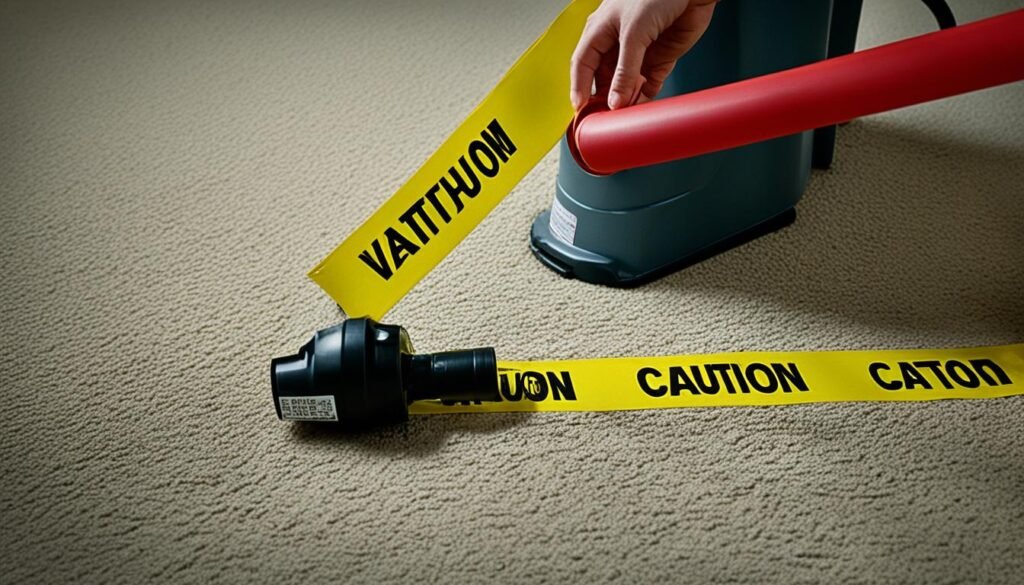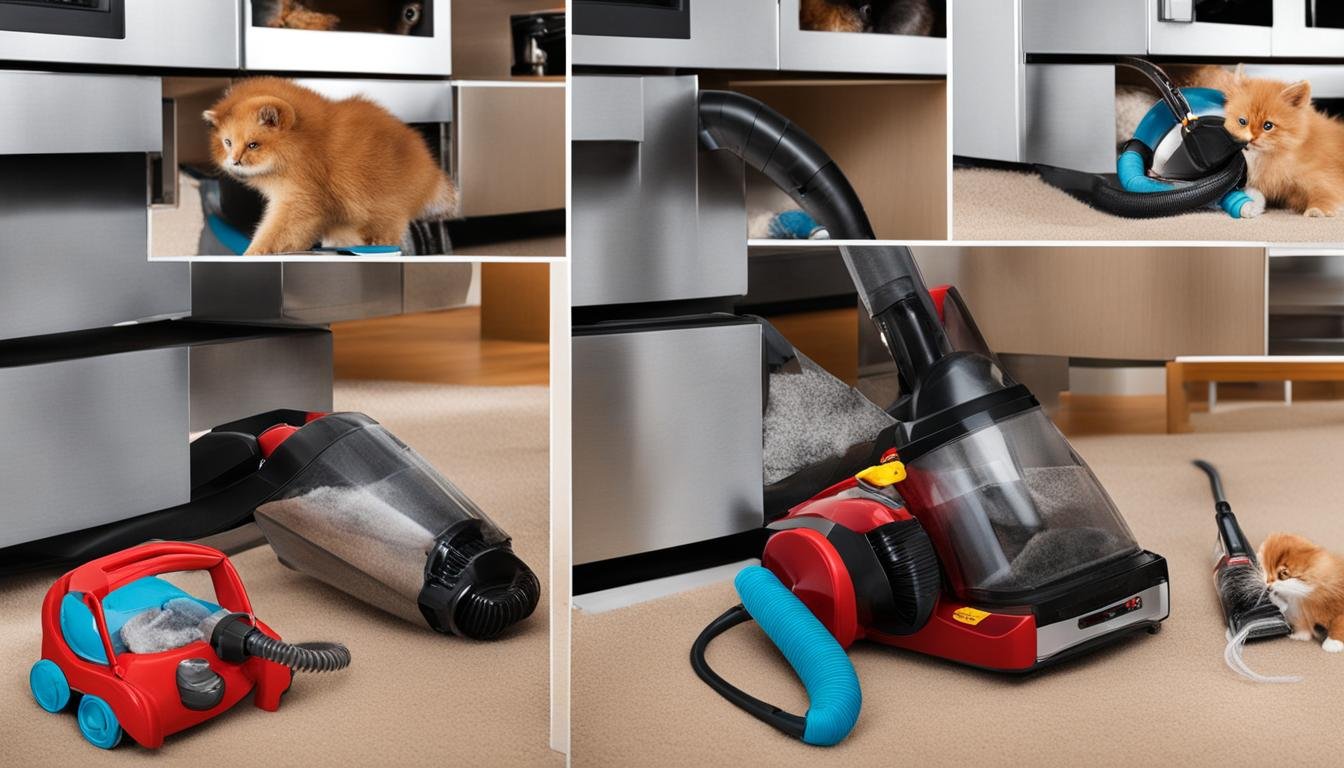Vacuum cleaners have become a common household appliance, but there has always been a lingering myth surrounding them – the belief that they can suck out your eye. In this article, I will delve into the origins of this myth, explore the marketing strategies employed by vacuum cleaner companies, and investigate the truth through experiments and research.
While consumer-grade vacuum cleaners may not have enough suction power to actually pull out an eye, it is essential to understand the dangers and risks associated with using a vacuum cleaner on your eye. Accidents can happen, and it’s crucial to take measures to prevent any potential injuries.
Key Takeaways:
- Using a vacuum cleaner on your eye can be dangerous, even if it may not have enough suction power to actually pull out your eye.
- Preventing accidents is crucial, and it’s important to understand the risks involved with using a vacuum cleaner improperly.
- Follow safety guidelines and keep your eyes protected when using a vacuum cleaner or any other household appliance.
- Consult a medical professional immediately if you experience any eye injuries while using a vacuum cleaner.
- Always prioritize safety and exercise caution to avoid any accidents or harm.
The Evolution of Vacuum Cleaners and Marketing Strategies
The evolution of vacuum cleaners has seen remarkable advancements in functionality and design, revolutionizing the way we clean our homes. From the humble beginnings of manual carpet sweepers to the high-tech, automated machines we have today, the vacuum cleaner industry has come a long way in meeting the needs of consumers.
Beyond the technological advancements, vacuum cleaner companies have also employed unique marketing strategies to promote their products. They showcase the extraordinary feats their vacuum cleaners can achieve and emphasize the lifestyle appeal of owning their brand. One notable example is Dyson, a prominent name in the industry.
Dyson revolutionized the market with its bagless technology, sleek design, and innovative range of products. Their vacuums offered not only superior performance but also a sense of eco-friendliness and modernity. These features resonated with consumers, placing Dyson at the forefront of the industry.
However, not all marketing strategies employed by vacuum cleaner companies have been met with praise. Some have been met with controversy and criticism for exaggerating product capabilities or misleading claims. In an industry where competition is fierce, companies sometimes resort to controversial marketing tactics to stand out in the market.
“Our vacuum cleaners use patented technology that captures even the tiniest dust particles, ensuring a cleaner and healthier home for you and your family.”
While these strategies may succeed in capturing consumer attention, they can also raise doubts and questions about the authenticity of the product claims. Consumers should be cautious and evaluate these marketing messages critically before making a purchase decision.
For a visual representation of the evolution of vacuum cleaners and their marketing strategies, take a look at the table below:
| Decade | Advancements in Vacuum Cleaners | Marketing Strategies |
|---|---|---|
| 1900s | Introduction of motorized vacuum cleaners | Emphasized time-saving convenience |
| 1950s | Transition from manual to electric vacuum cleaners | Stressed technological superiority |
| 1990s | Bagless vacuum cleaners introduced | Showcased eco-friendliness and modern design |
| 2010s | Introduction of smart features and robotic vacuums | Highlighted convenience and time-saving capabilities |
As the table demonstrates, vacuum cleaners have undergone significant advancements over the years, with marketing strategies evolving alongside the technology. Understanding this evolution provides valuable insights into the industry and the motivations behind consumers’ purchasing decisions.
Debunking the Myth: Can a Vacuum Cleaner Suck out Your Eye?
To put an end to the age-old myth of a vacuum cleaner pulling out an eye, a daring eye suction experiment was carried out using a pig’s head as a stand-in for a human eye. The purpose was to test the suction power of both a household vacuum and an industrial vacuum pump.
The results of the experiment were quite revealing. The household vacuum cleaner, although capable of generating a strong suction force, did not possess enough power to actually extract an eye. However, when the industrial vacuum pump was employed, the suction force was strong enough to cause serious harm to the eye.
This experiment serves as a compelling visual demonstration of the dangers and risks associated with using a vacuum cleaner on your eye. It highlights the importance of exercising caution and prioritizing safety.
Using a vacuum cleaner on the eye can lead to severe injuries, including lacerations, damage to blood vessels, and even permanent vision loss. It is crucial to understand these risks and avoid any actions that could result in harm.
The Power Difference: Household Vacuum vs. Industrial Vacuum
To better understand the stark contrast in suction power between a household vacuum and an industrial vacuum pump, let’s take a look at the following table:

| Vacuum Type | Suction Power | Eye Extraction Potential |
|---|---|---|
| Household Vacuum | Standard suction power for everyday cleaning | No |
| Industrial Vacuum Pump | Significantly higher suction power | Yes |
The table clearly shows that while a household vacuum cleaner is not capable of pulling out an eye, an industrial vacuum pump has the potential to cause severe eye injuries if misused.
“It is crucial to prioritize safety and avoid using a vacuum cleaner on the eye. The experiment proves that even a household vacuum cleaner, though not powerful enough to extract an eye, can still pose risks and cause serious injuries when used improperly.”
Understanding these eye dangers and risks associated with vacuum cleaners emphasizes the importance of adhering to safety guidelines. It is vital to protect our eyes and exercise caution when using household appliances, including vacuum cleaners.
Conclusion
In conclusion, it is crucial to prioritize your safety and take precautions when using a vacuum cleaner, particularly near your eyes. While the myth of a vacuum cleaner sucking out your eye may not be true for consumer-grade models, there are still potential dangers and risks involved.
To avoid vacuum cleaner accidents and potential eye injuries, it is important to exercise caution and follow eye safety precautions. Always handle the vacuum cleaner as intended and avoid any actions that may cause harm. Remember, prevention is key to avoiding accidents.
When using household appliances, including vacuum cleaners, it is essential to protect your eyes and practice safety measures. Consider wearing protective eyewear when operating the vacuum cleaner, especially in situations where dust or debris may be airborne.
By being mindful of eye safety precautions and exercising caution while using a vacuum cleaner, you can minimize the risk of accidents and protect your vision. Stay safe and prioritize your eye health when it comes to household chores and appliance operation.
FAQ
Can a vacuum cleaner really pull your eye out?
No, consumer-grade vacuum cleaners do not have enough suction power to pull out an eye. However, it is important to understand the potential dangers and risks associated with using a vacuum cleaner on your eye.
What are some eye injury prevention tips when using a vacuum cleaner?
To prevent eye injuries while using a vacuum cleaner, follow these safety tips: never put the vacuum cleaner nozzle near your eye, avoid aiming the nozzle at your face, wear protective eyewear if necessary, and keep children and pets away from the vacuum cleaner while in use.
Are there any specific vacuum cleaner safety tips to consider?
Yes, here are some important vacuum cleaner safety tips: always read the instruction manual before use, use the vacuum cleaner on appropriate surfaces only, make sure the power cord is not frayed or damaged, and unplug the vacuum cleaner before cleaning or maintaining it.
What are the potential dangers of using a vacuum cleaner on your eye?
Using a vacuum cleaner on your eye can result in serious injuries, including lacerations, damage to blood vessels, and potential permanent vision loss. It is crucial to prioritize safety and avoid any actions that may cause harm.
How can I prevent accidents with vacuum cleaners?
To prevent accidents with vacuum cleaners, follow these tips: always keep the vacuum cleaner in good working condition, keep the area being vacuumed well-lit and free from obstacles, avoid overstretching the power cord, and store the vacuum cleaner in a safe place when not in use.
What precautions should I take to ensure eye safety when using a vacuum cleaner?
To ensure eye safety when using a vacuum cleaner, remember to never put the nozzle near your eye, avoid aiming the nozzle at your face, and wear protective eyewear if necessary. Additionally, it is important to exercise caution and use the vacuum cleaner as intended.





Leave a Reply